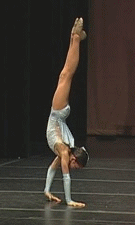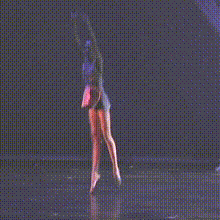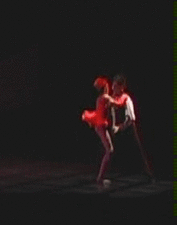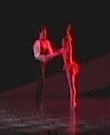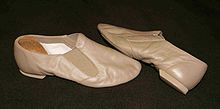
Gymnastics is a type of sport that includes physical exercises requiring balance, strength, flexibility, agility, coordination, artistry and endurance. The movements involved in gymnastics contribute to the development of the arms, legs, shoulders, back, chest, and abdominal muscle groups. Gymnastics evolved from exercises used by the ancient Greeks that included skills for mounting and dismounting a horse, and from circus performance skills.

A shoe is an item of footwear intended to protect and comfort the human foot. Though the human foot can adapt to varied terrains and climate conditions, it is vulnerable, and shoes provide protection. Form was originally tied to function, but over time, shoes also became fashion items. Some shoes are worn as safety equipment, such as steel-toe boots, which are required footwear at industrial worksites.
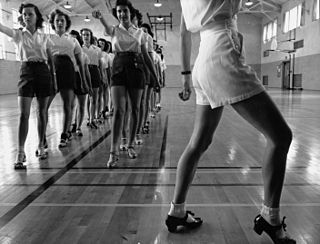
Tap dance is a form of dance that uses the sounds of tap shoes striking the floor as a form of percussion; it is often accompanied by music. Tap dancing can also be a cappella, with no musical accompaniment; the sound of the taps is its own music.
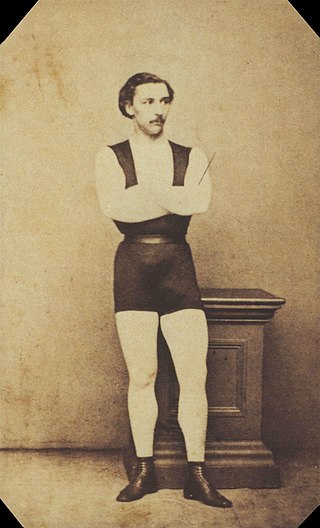
A leotard is a unisex skin-tight one-piece garment that covers the torso from the crotch to the shoulder. The garment was made famous by the French acrobatic performer Jules Léotard (1838–1870). There are sleeveless, short-sleeved, and long-sleeved leotards. A variation is the unitard, which also covers the legs. It provides a degree of modesty and style, while allowing for freedom of movement.
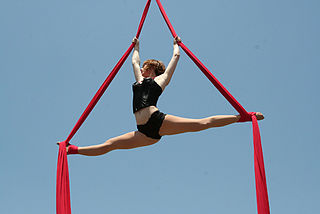
Acrobatics is the performance of human feats of balance, agility, and motor coordination. Acrobatic skills are used in performing arts, sporting events, and martial arts. Extensive use of acrobatic skills are most often performed in acro dance, circus, gymnastics, and freerunning and to a lesser extent in other athletic activities including ballet, slacklining and diving. Although acrobatics is most commonly associated with human body performance, the term is used to describe other types of performance, such as aerobatics.

Clogs are a type of footwear made in part or completely from wood. Used in many parts of the world, their forms can vary by culture, but often remained unchanged for centuries within a culture.
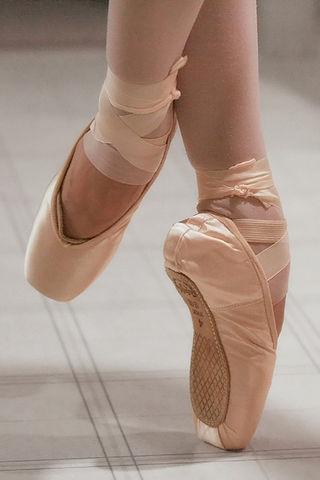
A pointe shoe, also called a ballet shoe, is a type of shoe worn by ballet dancers when performing pointe work. Pointe shoes were conceived in response to the desire for dancers to appear weightless and sylph-like and have evolved to enable dancers to dance en pointe for extended periods of time. They are manufactured in a variety of colors, most commonly in shades of light pink.

Geta (下駄) are traditional Japanese footwear resembling flip-flops. A kind of sandal, geta have a flat wooden base elevated with up to three "teeth", held on the foot with a fabric thong, which keeps the foot raised above the ground.
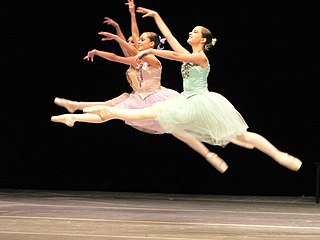
Concert dance is dance performed for an audience. It is frequently performed in a theatre setting, though this is not a requirement, and it is usually choreographed and performed to set music.
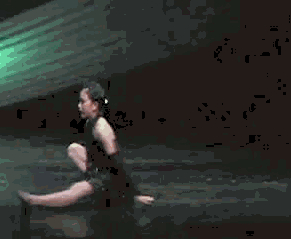
A back walkover is an acrobatic maneuver in which a person transitions from a standing position to a back bridge and then back to a standing position again, undergoing a complete revolution of the body in the process. Back walkovers are commonly performed in a variety of athletic activities, including acro dance, cheerleading, and rhythmic gymnastics. In artistic gymnastics, back walkovers are performed in floor exercises and on the balance beam.

Skate shoes or skateboard shoes are a type of footwear specifically designed and manufactured for use in skateboarding. While numerous non-skaters choose to wear skate shoes as they are popular in fashion, the design of the skate shoe includes many features designed especially for use in skateboarding, including a vulcanized rubber or polyurethane sole with minimal tread pattern or no pattern, a composition leather or suede upper, and reinforced stitching to extend the life of the upper material. The most important aspect of skate shoes is that they have flat soles which allow the skater to have better board control.
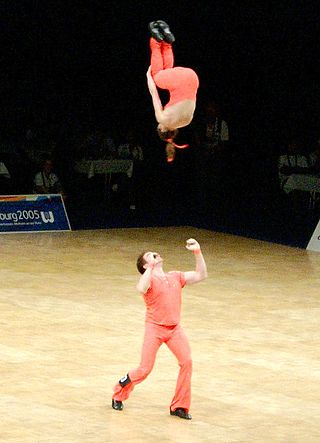
Acrobatic rock and roll is a fast, athletic, physically demanding form of partner dance that originated from Lindy Hop but has evolved to a choreographed sport, often done in formal competition. It is danced by both couples and groups, either all-female or four to eight couples together.

Acrobalance is a floor-based acrobatic art that involves balances, lifts and creating shapes performed in pairs or groups. A performer on the ground doing the lifting and supporting in an acrobalance formation is often called the base, while a performer being lifted or tossed can be referred to as the flyer. Formats include male/female duo, trio, female/female, and other variations.

Adagio is the performance of partner acrobalance poses and associated movements that involve stationary balances by a pair of performers. It is performed in professional circus, in various dance disciplines including acro dance and ballet, in pair skating, and as a hobby in university circus groups.
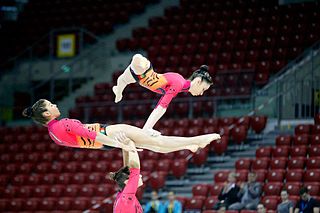
Acrobatic gymnastics is a competitive discipline of gymnastics where partnerships of gymnasts work together and perform figures consisting of acrobatic moves, dance and tumbling, set to music. There are three types of routines; a 'balance' routine where the focus is on strength, poise and flexibility; a 'dynamic' routine which includes throws, somersaults and catches, and a 'combined' routine which includes elements from both balance and dynamic.
A performance surface is a type of flooring with attributes suitable for dance or sport. The word performance in this context will refer to any means of displaying physical movement. This includes theatrical, athletic, and recreational forms of performance. However, these different disciplines all require specialized floors to accommodate their specific physicality. Performance surfaces are normally designed as a sprung floor with additional material or layers on top, to create a complete dance floor or sports floor. Dance performance surfaces are denoted by using a layer of Marley, a popular type of vinyl, on top of a sprung floor. Theatres often have a number of roll-out floors with different characteristics to satisfy the requirements of different forms of dance. In addition, athletic flooring has been found to require different and new technological mechanisms to enhance performance. Flooring for spaces like clubs or ballrooms also serves a different purpose and therefore utilizes different properties.

An acrobatic flip is a sequence of body movements in which a person leaps into the air and then rotates one or more times while airborne. Acrobatic flips are performed in acro dance, free running, gymnastics, cheerleading, high jumping, tricking, goal celebrations and various other activities. This is in contrast to freestyle BMX flips, in which a person revolves in the air about a bicycle.
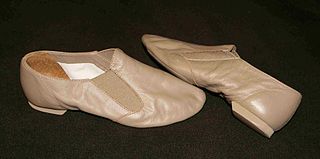
A jazz shoe is a type of shoe worn by dancers. They were popularized in jazz dance and other styles of dance including acro dance, acrobatic rock'n'roll, and in other activities, such as aerobics. Jazz dance can be done in any type of shoe—jazz originated as a social dance and was done in everyday clothes and shoes. Oxford shoes were only popularized as jazz dance shoes in the mid 20th century when the dance form made its way out of the clubs and onto the stage.
Hand to hand acrobatics is a type of performance in which an acrobatic base and flyer balance on top of each other in either a gymnastic or acrobatic medium. It combines strength, agility, flexibility, and balance. For it to be considered hand to hand acrobatics, the top performer (flyer) must be making physical contact only with the base's hands, with the flyer's hands keeping them balanced. Positions the top can perform in this style of acrobatics are straddles, handstands, pikes, press to handstand, one arm handstands, planches, flags, and many others. Hand to hand acrobatics can also include dynamic catches and throws that either begin with a throw from a hand to hand position or end in a catch in the hand to hand position.



